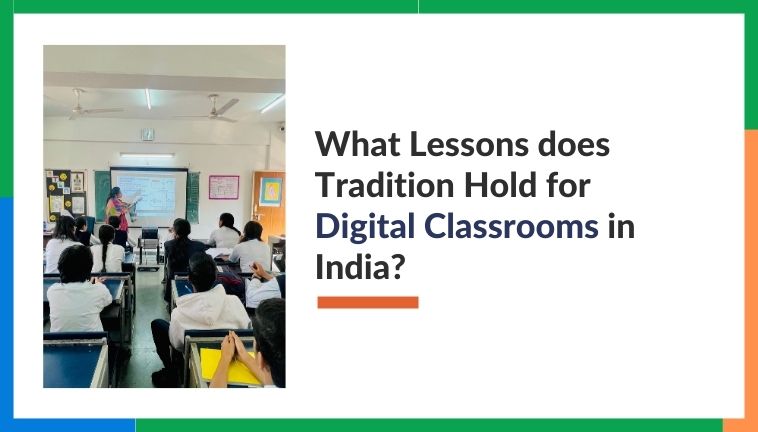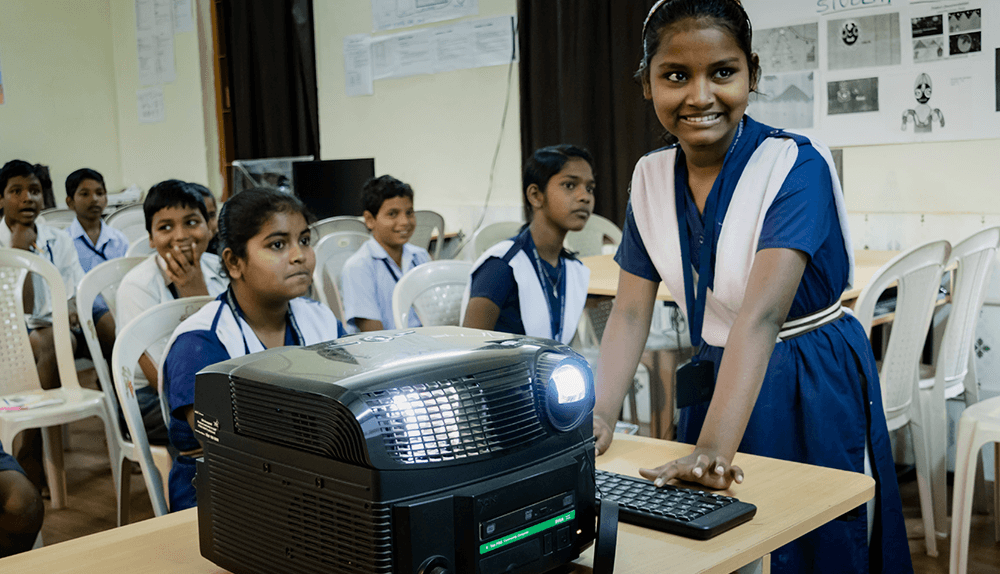Blogs
What Lessons does Tradition Hold for Digital Classrooms in India?

Have you ever heard the term "digital classrooms" or had the opportunity to teach in one? While smart classes and smart boards have been around in education for some time, the question is: What truly makes a classroom "smart"?
MarketResearch.com projects that the global EdTech and digital classroom market will reach a massive USD 333.3 billion by 2027, as outlined in the ‘EdTech & digital classroom Market Intelligence Report Global Forecast to 2027.’ Similarly, India’s digital classroom market is on the rise, expected to grow at a CAGR of 4.05% and reach an impressive USD 16.1 billion by 2026.
Indian classrooms could soon look very different from what we’re used to. Picture a classroom where blackboards are replaced with digital whiteboards, where AI helps teachers customize lessons for each student, and where virtual reality makes subjects come alive. This isn’t science fiction—it’s the future of education, and it’s already unfolding in some parts of the world.

What is a Digital Classrooms?
A digital classroom Solution uses advanced technology to enrich learning. Tools like smart boards in classrooms, Tablets, Projectors, and Digital Content are now essentials in many classrooms. These tools encourage teachers to try new teaching styles, which improves student understanding and keeps them engaged. This, in turn, makes students more active and excited about their lessons.
As India embraces this shift toward digital classrooms, it’s essential to consider how these changes intersect with teacher training and cultural values. In a country rich with traditions, festivals, and cultural diversity, integrating smart technology in a way that respects these elements is key. Digital classrooms, teacher training, and Indian culture can together shape a modern learning environment. This approach blends innovation with tradition, keeping students connected to their roots.
Why is there a divide between Digital Classrooms & Tradition?
Digital classrooms and teacher training programs have great potential to enrich education. However, they currently focus mainly on academic subjects, leaving cultural content largely unexplored. As a result, the rich cultural context of Indian education is often neglected.
Reasons:
- Curriculum Design: The existing curriculum is largely academic, prioritizing subjects that are tested in exams, with little room for cultural content.
- Limited Resource Availability: Educational technology resources predominantly cater to standard subjects, with scarce materials focused on cultural education.
- Teacher Training Gaps: Teacher training programs do not adequately prepare educators to incorporate cultural themes into their teaching.
- Focus on Digital Literacy: There is an emphasis on digital literacy and technology skills, overshadowing the importance of cultural education.
- Insufficient Policy Framework: Education policies may not mandate or emphasize the inclusion of cultural education in digital classroom settings.
Exam Pressure: Lack of Effort in Understanding Our Culture through Technology
Both traditional and digital classrooms primarily aim to improve academic outcomes. This focus often results in the systemic neglect of cultural education. This objective reflects broader societal values that equate educational success with academic achievement.
Reasons:
- Career-Oriented Mindset: Society often equates educational success with job readiness and economic advancement, prioritizing skills that yield immediate career benefits.
- Pressure from Parents and Institutions: Parents and schools prioritize grades and academic accomplishments over cultural enrichment, fostering a competitive environment.
- Inadequate Policy Framework: Education policies may lack clear directives on the importance of cultural education, leading to its devaluation.
- Historical Educational Focus: The education system has historically prioritized academic learning, reinforcing the idea that cultural education is secondary.
- Lack of Integration in Teacher Training: Teacher training programs rarely emphasize the role of cultural understanding in fostering holistic student development.
How can Digital Classrooms bridge the gap between Tradition, Teaching, and Technology?
With India embracing technological advancements, there's an opportunity to enrich learning by integrating its diverse cultural heritage. This approach helps shape students' identities while fostering deeper connections to their roots. Integrating cultural content, improving teacher training, and leveraging technology can create a richer educational experience. This approach fosters an environment that respects and celebrates India’s diverse traditions.
Here’s how digital classrooms can bridge the gap:
1. Integration of Cultural Content
- Importance of Cultural Education: Cultural education enhances students' understanding of their heritage, fosters a sense of identity, and promotes inclusivity among diverse student populations. Teaching about regional festivals like Pongal or Diwali helps preserve these traditions. It also enables students to appreciate the diversity within their country.
- Content Development: Developing digital resources that focus on cultural topics, such as folk stories, regional art forms, and traditional music, can enrich the curriculum. E-learning platforms and smart boards can offer interactive modules on festivals like Onam or Baisakhi, making lessons more engaging. This approach can also deliver relevant content in native languages for better understanding.
- Interactive Learning: Incorporating multimedia tools, such as videos and interactive exploriments, can significantly enhance the engagement of cultural learning. For instance, by utilizing virtual reality tours or projecting live 3D tours of historical sites like Hampi or Jaipur using digital classroom devices, students can connect with their cultural heritage firsthand.
2. Teacher Training and Development
- Professional Development: Workshops designed to help teachers integrate cultural content into their lesson plans can be instrumental. For example, a workshop on incorporating local folk tales into English or regional language classes can empower teachers to bring cultural narratives into their teaching.
- Cultural Competency Training: Providing training focused on understanding and teaching diverse cultural perspectives ensures that teachers are prepared to address all students’ backgrounds.
- Collaboration with Cultural Experts: Involving local artists, historians, and cultural practitioners in teacher training can enhance educators’ ability to teach cultural content authentically. For example, inviting local artisans to demonstrate traditional crafts in teacher workshops can provide practical insights into cultural practices.
3. Use of Technology
- Digital Tools for Cultural Education: Utilizing educational apps and online platforms that focus on cultural topics can make learning accessible and engaging. For instance, apps that teach students about different Indian languages and their scripts can help them appreciate linguistic diversity.
- Gamification of Learning: Developing games that incorporate cultural elements can make learning fun and interactive. For example, a quiz app on Indian festivals where students can earn points for correct answers can motivate them to learn more about their culture.
- Virtual Classrooms: Using technology to connect students with cultural experts across India can enhance learning experiences. For instance, virtual guest lectures from historians or artists using smart boards in classrooms can provide insights into the significance of various cultural practices.
4. Assessment and Feedback
- Culturally Relevant Assessments: Designing assessments that reflect students' understanding of cultural content can help evaluate their engagement with the material. For example, project-based assessments where students create presentations on local traditions can showcase their learning effectively.
- Feedback Mechanisms: Implementing feedback systems to gather input from students, teachers, and parents can significantly refine cultural integration strategies. For instance, by including arts, culture, and festival-related questions in formative assessments, we can effectively analyze student responses. This approach allows us to use AI-enabled assessment apps to enhance our understanding of their engagement with cultural content.
- Monitoring Progress: Assessing the impact of cultural education on student engagement and understanding can guide further improvements.
In Conclusion
Digital classrooms hold the potential to transform learning by blending tradition with technology. With Schoolnet’s world-class, tech-centric solutions, schools can seamlessly integrate advanced digital tools tailored to India's unique educational needs. By incorporating cultural content, training teachers to be culturally aware, and using innovative tools, we can build an educational system that celebrates diversity while fostering academic success. Embracing India’s rich heritage through digital platforms and engaging assessments not only allows students to connect with their roots but also helps them thrive in a modern, tech-driven world. Consequently, as we bridge the gap between tradition and technology, we create a classroom that not only prepares students for the future but also honors their past.





